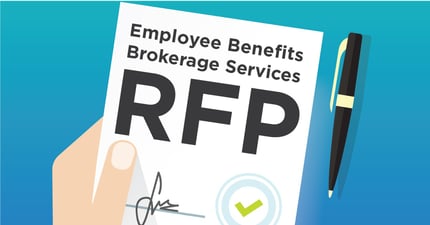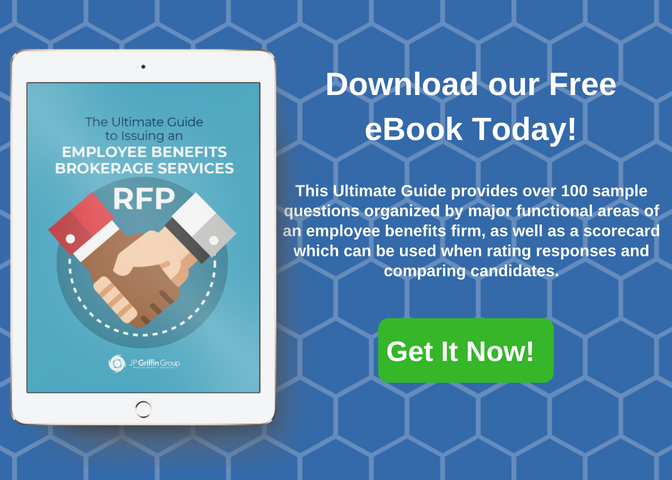 It’s certainly up for debate whether or not an RFP (Request for Proposal) is really the best method of finding a new employee benefits broker for your business. Nevertheless, if you’re planning on issuing an RFP for a new employee benefits advisor, it’s important to do it right.
It’s certainly up for debate whether or not an RFP (Request for Proposal) is really the best method of finding a new employee benefits broker for your business. Nevertheless, if you’re planning on issuing an RFP for a new employee benefits advisor, it’s important to do it right.
After all, a relationship between you and your employee benefits broker can span 10 years or more. Shouldn’t you strive for the best partnership imaginable? The RFP process is a time-consuming one, but when it’s done well, it creates a fruitful relationship with a trusted and highly valued business partner for years (and hopefully decades) to come.
Here’s a complete guide to issuing an RFP for employee benefits — and don’t forget to download our RFP template for additional help with getting started!
Writing an Employee Benefits RFP
First Things First: What is an RFP?
A request for proposal is “a type of bidding solicitation in which a company or organization announces that funding is available for a particular project or program, and companies can place bids for the project's completion.” In the case of employee benefits, a company is saying that they’re interested in hiring an employee benefits broker and that they’re open to new advisors.
In a way, an RFP is a little bit like a job description, stating exactly what the issuing company needs, from resources to reporting to cost-saving initiatives, and will ultimately help them codify the evaluation criteria on which the vendors’ proposals will be assessed. Essentially, the RFP should ensure all parties are on the same page in terms of requirements.
Additionally, RFPs should include background on the issuing organization, such as its lines of business, needs and expectations, as well as a set of specifications that describe the ideal solution.
Why an RFP?
It’s important to ask yourself why you’re issuing an RFP in the first place. Do you have performance issues with your current employee benefits broker? Is it a required diligence obligation? Are you simply canvassing the marketplace to see if there are better options available than your current benefits broker? Or are you looking to hire an employee benefits advisor for the first time?
 Approaching the RFP process with the answers to these questions in the back of your mind will help you maintain your focus and objectives. For example, if you’re simply canvassing for better options, make sure to ask a few questions to mine additional information from each employee benefits broker, such as “What question(s) haven’t we asked?” or “What do you see being our three biggest challenges in the years ahead?” Of course, this second question requires you to give some business-specific information in order to get something helpful in return — or you could choose to save that one for a phone call or an in-person meeting after the initial request for proposal.
Approaching the RFP process with the answers to these questions in the back of your mind will help you maintain your focus and objectives. For example, if you’re simply canvassing for better options, make sure to ask a few questions to mine additional information from each employee benefits broker, such as “What question(s) haven’t we asked?” or “What do you see being our three biggest challenges in the years ahead?” Of course, this second question requires you to give some business-specific information in order to get something helpful in return — or you could choose to save that one for a phone call or an in-person meeting after the initial request for proposal.
Questions like this will go a long way in helping you learn something new — and quite possibly will shed light on performance or service-level deficits with your current benefits advisor. In fact, most HR personnel (especially those who haven’t gone through the RFP process in many years) don’t realize that most employee benefits brokers today provide a much higher level of service than they used to.
How You Know It’s Time to Begin the RFP Process
In our opinion, you should consider shopping around for a different employee benefits broker when any (or all) of the following describes your situation:
- You’re dissatisfied with your current broker’s performance, whether it’s a quality of service or financial issue (providing the latter is something controllable).
- Your business has grown substantially since the last time you hired an employee benefits broker and your needs have changed, and the solutions you put in place long ago no longer fit with your company.
- Your broker appears to be self-serving, seeming to work more for themselves or your insurance carriers partners than for you.
- You’ve been with the same benefits advisor for a long time and you wish to educate yourself on the current standard offerings of brokers in your market.
- You feel your employee benefits broker has become complacent after working together for so long — as if perhaps they don’t think you’ll ever leave, and they aren’t putting forth their best effort.
The Top Reasons Employers Fire Their Employee Benefits Broker
Zywave surveyed 623 employers across all regions of the United States in 2017 regarding their reasons for firing their benefits advisor. The overwhelming majority of respondents were from companies employing fewer than 500 people.
Here’s what these respondents listed as the top eight factors that would lead them to make a change in brokers:
- 69% said their broker doesn’t provide prompt and effective service or answer questions in a timely manner.
- 42% believe their advisor only sells insurance without providing trusted advice.
- 38% said their broker lacks consistent communication.
- 33% said their broker doesn’t offer resources to keep their company in compliance with complex laws and regulations.
- 29% believe their broker lacks understanding of their company or expertise in their relevant industry.
- 24% were interested in switching if another broker was able to negotiate lower premiums for their workforce.
- 22% feel their broker doesn’t provide a strategic plan consistent with their business needs.
- 22% feel their broker doesn’t provide a wide enough range of services to meet necessary HR, wellness, plan design, risk management and/or other employee safety needs.
When examining employee benefits brokerage services even further, these same Zywave respondents ranked the following core capabilities as the most important to their organizations:
- Compliance
- Employee Communications
- Plans Design & Benchmarking
- Claims Analysis & Reporting
- Employee Advocacy & Assistance
- Enrollment and Onboarding Tools
- Wellness
The Pros and Cons of Issuing an Employee Benefits RFP
The possible upsides to issuing an RFP for employee benefits include the following:
- A standard set of questions will yield an apples-to-apples comparison of answers (which can be scored — a subject we’ll tackle later on).
- A request for proposal helps you guide the conversation, meaning you’ll get answers to questions that are important to you versus a broker-led discussion, which is often predetermined and doesn’t necessarily address your concerns.
- The process of putting together an RFP can often times challenge you to craft a very clear vision of what is needed, how it could be accomplished, and by what deadline.
- The RFP process helps to sometimes negotiate lower costs (or more importantly, better value) for the project.
- RFP vendor responses can help identify false assumptions or unrealistic expectations you may have.
- The RFP process can reveal whether portions of the project can be managed internally, or in some cases, by a separate vendor.
The downsides of issuing an RFP for employee benefits include the following:
- It’s time-consuming to review RFP submissions from numerous employee benefits brokers, many of which could be upwards of 100 pages.
- RFPs are sometimes better suited for procurement-driven commodities. Hiring an expert to manage your employee benefits program doesn’t quite fit that mold as you’re purchasing expertise, not products.
- If your questions restrict responses to only what you think you should be asking, you could be missing out on important information that could help you make better decisions for your workforce.
- It requires a formal screening process, multiple reviews, meetings, presentations, and follow-ups.
- The RFP process requires tremendous key stakeholder engagement within your organization.
How to Structure the RFP Process
Before You Start Writing A Single Word
Before you can bring potential employee benefits brokers into the foray, the first thing that needs to happen in the RFP process is to have internal discussions. Identifying several crucial factors upfront will save you countless miscommunications and potential setbacks later.
Key internal questions should include:
- Have we selected a project manager? It’s crucial to establish who the point person will be if respondents have questions. The project manager will also be responsible for making sure the process keeps moving.
- Have we established the key stakeholders? You’ll want to include HR, finance, and IT in those considerations. Be sure to involve all of your key stakeholders and evaluators early in the RFP process.
- Have we established a budget and ideal compensation structure for services? Keep in mind that it’s critical to have both the input and approval
 from your Finance department in these matters, ideally prior to looking for providers. Also remember that employee benefits brokers can help you do more than just bring down the cost of benefits, and sometimes the best they can do is slow the rate of increase. Net, it's often times wise to look at bottom line results rather than just topline costs. (A benefits program which costs more than prior year but leads to a healthier workforce and/or better workforce retention and talent recruitment might be actually costing your company less overall.)
from your Finance department in these matters, ideally prior to looking for providers. Also remember that employee benefits brokers can help you do more than just bring down the cost of benefits, and sometimes the best they can do is slow the rate of increase. Net, it's often times wise to look at bottom line results rather than just topline costs. (A benefits program which costs more than prior year but leads to a healthier workforce and/or better workforce retention and talent recruitment might be actually costing your company less overall.)
- What are our critical deal breakers? Ask your team what, if anything, would eliminate broker candidates. For example, if your HR department absolutely needs access to HR software, make sure your RFP specifically states such — and that you only review submissions from brokers who can deliver on that requirement.
- How are we going to evaluate candidates? A common pitfall associated with assessing responses from RFPs is the lack of an evaluation and scoring process. Remember, you can’t measure something if you’re not sure what you’re evaluating.
- What is our main goal? Visualize what success looks like and the biggest determining factors involved.
- Will we offer a formal Q&A session? Holding a Q&A session after publishing your RFP will ensure everyone is on the same page, so long as you invite everyone to attend. This will also serve you well as it relates to managing your time and your prospects’ expectations. (Conversely, handling Q&A on a prospect-by-prospect basis could inadvertently give one broker an unfair advantage.)
Remember that these questions are just for internal use. There are plenty of other questions you’ll need to reserve for potential employee benefits brokers.
What Types of Questions You Should Ask Broker Prospects
Our free, easy-to-use RFP template, which includes over 100 sample questions categorized by broker function, as well as scoring grid, is available for download now. It can help you get started on your RFP process.
A typical employee benefits broker RFP contains between 20 and 50 questions, which typically span 10 primary categories and include the following topics:
- General Information: History of the firm, ownership and organizational structure, experience within your industry, experience within your geographic market.
- Account Management Services: Structure of department, team biographies and resumes, project management capabilities, and scope of services (such as employee assistance and advocacy, open enrollment assistance, new hire onboarding, enrollment technology, employee communication services).
- Strategic Planning, Underwriting, and Actuarial Services: Short-term and long-term planning, goal setting, plan design, contribution analysis, vendor negotiations, contract review, data analysis, reporting, benchmarking capabilities, financial projections, and claims analysis.
- Compliance: Legal counsel access and expertise, document preparation and filing, on-going education and alerts, HIPAA compliance, ACA compliance, federal, state, and local legislative education and compliance, and other resources to assist with ad hoc compliance issues.
- Communication & Employee Engagement: Open enrollment materials and services, new hire onboarding materials services, HR technology, automation resources and platforms, and ongoing communication efforts.
- Wellness: Program oversight, goal setting, vendor coordination, awards and recognition, process for measuring success or failure, etc.
Additionally, it’s not uncommon for a request for proposal to include two additional sections, though some companies choose to hold these questions in reserve for finalists:
- Fees: Commission or fee-based, one year versus multi-year. Make sure to ask if any services mentioned in the proposal aren't covered by the fees quoted.
- References: Ideally from clients of similar size, geography, industry, and complexity. Consider asking for at least one reference from a client who no longer works with them (in this way they won't be able to only provide you with clients who will give them a shining review).
What Information You Should Provide
The saying “garbage in, garbage out” is quite applicable to the RFP process. You want to be thoughtful and thorough with the information you provide. In return, you’ll receive thoughtful and thorough responses. Your RFP should provide invited participants with the following information: 
- Process Schedule: This should include the key dates and times, such as the date you wish your contract to begin, question submission period, Q&A session, response submission deadline, finalists decision, finalists interviews, award selection, and broker of record declaration.
- Key Contacts: This should include a specific person to whom respondents can contact with any questions during the process, as well as the point of contact for final submission of proposals. (Note that it’s not uncommon for companies to insist all questions be submitted in writing, and that all answers be distributed to all participating parties. This ensures that everyone is on the same page during broker selection.)
- Procedural Rules: This should include the number of proposals to be delivered, where the proposals should be sent and to whom, and in what form (hard copy or digital).
- Company Background: Participants will appreciate a little insight into your firm’s history, mission, and values. More germane to the topic at hand, they would love to hear about your employee benefits philosophy, so make sure you have a clear vision. Is your goal to meet minimum requirements according to the law or set a best-in-industry standard?
- Existing Coverage Information: You’ll elicit the best responses to your employee benefits RFP if you provide a bit of information on your existing benefits program. Include details such as the number of eligible employees, number of covered lives on the plan, funding mechanisms, and current benefits offered with corresponding carriers. As far as medical coverage is concerned, it’s very helpful if you can share plan types, contributions, deductibles, out-of-pocket maximums, coinsurance, and copays.
- Assessment of Benefits Program: Perhaps the most valuable information for a potential employee benefits broker is your assessment of your current benefits program. How have your rates changed in the last few renewals? How has the operational execution of the last few open enrollments gone? What are the three largest challenges you’re facing with your current benefits program? Why are you shopping around for a new carrier?
- Disclaimers: You’ll want to reserve the right to reject proposals that don’t meet requirements, waive formalities, etc. Be sure to consult your in-house counsel for appropriate language.
How To Determine Who and How Many Brokers to Invite
We recommend inviting no more than three, but five or six at most — any more than that and you’ll drive yourself crazy trying to evaluate the proposals. You’re also more likely to get better responses if the brokers participating know they’re part of a small group who was asked to respond.
It’s a good idea to call a few business owners, CEOs, CFOs, board members, or heads of HR you respect to get the names of employee benefits brokers (not just firms) they trust. Consider choosing a mix of both privately held and publicly traded brokers, as each is likely to bring different skills, resources, and approaches to the table.
Don’t be overly concerned with total company size, nor the size of the blocks of business they place with carriers, but rather the breadth and depth of the team who would be working with your business. Larger brokers don’t necessarily have access to better rates than smaller ones. As for second round finalists, we would recommend no more than two or three for formal presentations and interviews.
Where Do We Find A List of Brokers to Invite?
If you don’t have any peers you can (or want to) call, then consult a business journal in your city, many of which publish a list of top employee benefits brokers,  even though they’re usually ranked by size, rather than a more meaningful ranking (like customer feedback). Regardless, if you’re looking for a place to start, it’s better than nothing.
even though they’re usually ranked by size, rather than a more meaningful ranking (like customer feedback). Regardless, if you’re looking for a place to start, it’s better than nothing.
You can also contact the International Foundation of Employee Benefit Plans (IFEBP), a leading objective source of relevant employee benefit education and information, as well as the Society for Human Resources Management (SHRM).
Lastly, don’t be afraid to Google (in fact, you should research all companies that submit RFPs). Spending five or ten minutes on a website can help you get a pretty good feel for the broker, which can help you determine if you might be interested in hiring them. For example, if their website looks dated and difficult to use, perhaps you don’t want them leading your benefits automation efforts. If their content is dense, full of industry jargon, and difficult to read, perhaps you don’t want them leading communication efforts with your workforce.
Appropriate Length of Time To Respond
Considering the time and effort you put forth in preparing your RFP, the last thing you want to do is preclude an employee benefits broker from responding because of an unrealistic turn-around time.
You’ll want to allow enough time for the brokers to absorb the request for proposal, ask questions, and then formulate their proposals. In that regard, four to six weeks seems reasonable, and not too long that the process will drag out indefinitely.
The Best Way To Evaluate RFPs for Employee Benefits
The easiest way to evaluate proposals is by setting up some type of scoring mechanism for each committee member to complete individually upon reviewing proposals. These scores can then be tabulated individually, you could hold a group scoring session where these individual scores simply inform the discussion, or you could create a system that uses both methods, where each committee member scores all proposals and then there is a group discussion about them.
Most score sheets are designed to correspond to the sections and specific questions asked in the RFP. We tend to favor scoring sheets which evaluate on a 1 to 5 scale (5 being the best), scoring each question on how well the broker's answer (if true), meets the requirements to complete an activity outlined in the RFP. In this way, each question is worth a total of 5 points, and those who answer each question in sufficient detail are rewarded more than those who are vague.
The review committee overseeing presentations should also have a scorecard that is tailored to in-person interviews. The final decision about the winning employee benefits broker is typically made a few days after presentations and interviews have finished.
The Right Time of Year to Start the RFP Process
The best time of year to issue a request for proposal is not right before renewal season, and it’s definitely not during open enrollment. The ideal time to start the RFP process is actually right after a renewal or when open enrollment closes.
 Why? Because every single challenge you faced and struggled with is still fresh in your mind. Plus, it will take you weeks, if not months to draft a request for proposal you really like (or one your bosses and senior management sign off on).
Why? Because every single challenge you faced and struggled with is still fresh in your mind. Plus, it will take you weeks, if not months to draft a request for proposal you really like (or one your bosses and senior management sign off on).
At the very latest, you should begin the RFP process no later than six months prior to your renewal. That should give you enough time to issue, review, and award the business while still giving the new employee benefits broker enough time to set up the renewal.
That being said, you can onboard a new broker at any time. Changing brokers during a plan year does not mean you’ll also have to change your plans, carriers, or networks. Everything can remain as-is until you decide to make a change to the program.
Timing the Employee Benefits Broker Transition
The timing is entirely up to you, but most employers have their new broker take over a few days after they announce their final selection. At that point, you essentially have a lame duck broker on your hands, anyhow.
Assigning your account to a new benefits advisor is as simple as submitting a broker of record letter to your carriers. Don’t worry, you don’t have to create yet another document — your new broker will have this template ready to go. Undoubtedly, they’ll be anxious to get started.
Before Diving In
Before diving into the RFP process we strongly recommend that you consult with a few of your peers in companies you respect around town. When consulting with smaller companies, try talking to the owner, while at larger companies it's probably best to talk to someone in finance and/or HR because they'll have more in-depth knowledge about their company's experience with their broker.
Ask them if they are happy with their current broker. If you keep hearing positive feedback with regards to a particular broker, or set of brokers, it might make sense to simply meet with each of them one on one. These discussions may help to inform your RFP or you may choose to skip the RFP process altogether.
If you do elect to go the RFP route, be sure to download our free "Ultimate Guide to Issuing an Employee Benefits Brokerage Services RFP" below. You can thank us later ;)
Are you looking to issue an employee benefits RFP? Leave us a comment below or contact us. We’d love to hear from you!

















